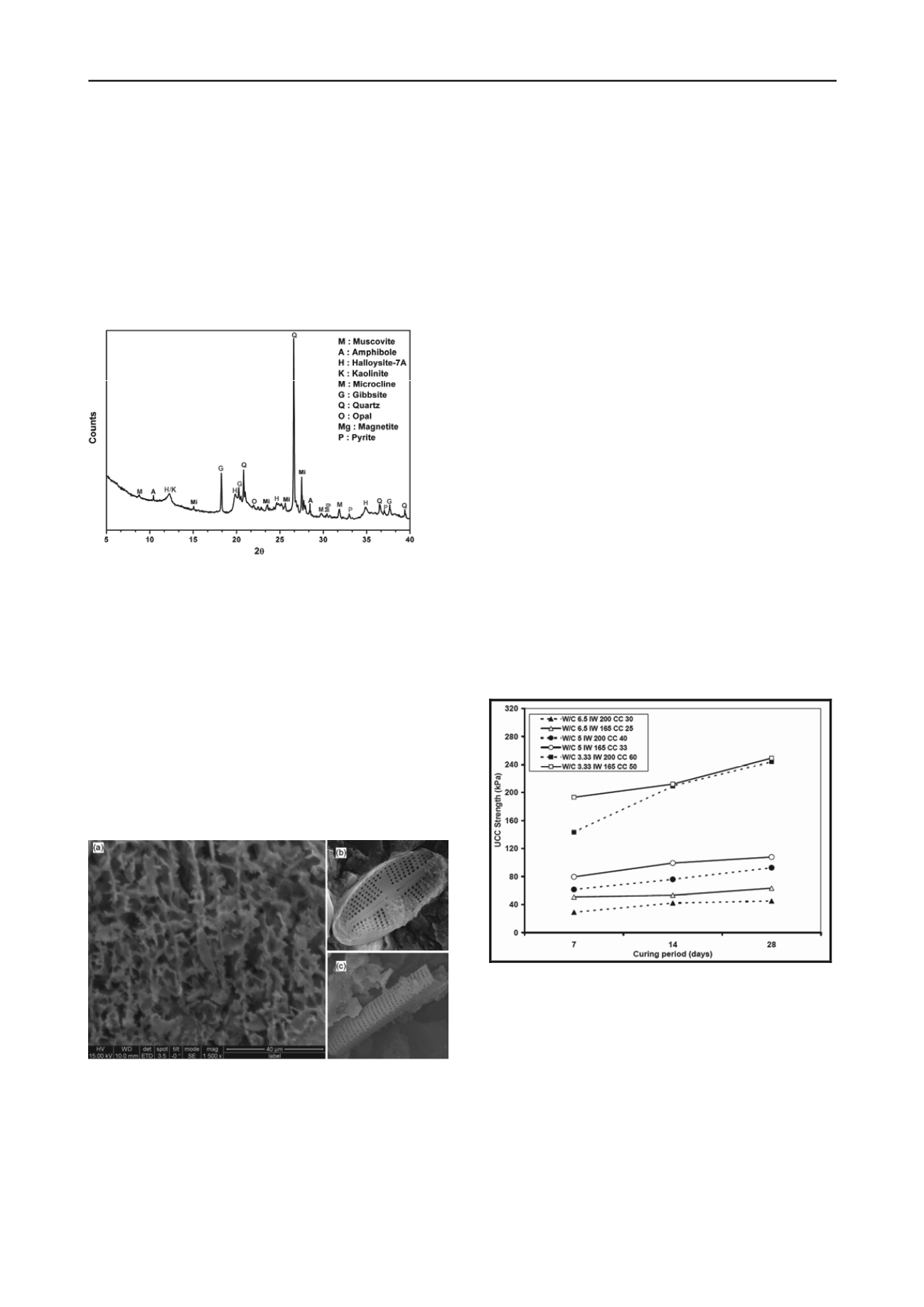
430
Proceedings of the 18
th
International Conference on Soil Mechanics and Geotechnical Engineering, Paris 2013
Proceedings of the 18
th
International Conference on Soil Mechanics and Geotechnical Engineering, Paris 2013
2.2 Soil Mineralogy
2.2.1 X-Ray Diffraction (XRD) Studies
XRD analysis was carried out using Bruker D8 Advance system
on powder samples. Samples were scanned using copper K
alpha (λ = 1.54 Å) radiation at a scanning rate of 1º/minute.
Identification of minerals was done by comparing the XRD
patterns got from the soil with the standard data sets of the
known minerals (JCPDF, Powder Diffraction File, 1990). The
peaks for the Kuttanad soil and its corresponding minerals are
shown in Fig. 1.
Figure 1. XRD of Kuttanad clay
2.2.2 Scanning Electron Microscopy (SEM)
The Quanta Environmental Scanning Electron Microscope
(ESEM) was used in analyzing the fabric of the uncemented and
cemented clay. A study of the micrographs of uncemented
Kuttanad soil sample prepared by freeze drying technique
indicates an open honeycomb type of fabric arrangement, as
shown in Fig. 2(a). The fabric shows the presence of frustules,
Fig .2(b & c), which are skeletal remains of diatoms, composed
of amorphous silica (opal, presence also verified by XRD
analysis). Diatomaceous frustules in marine sediments are
known to play a significant role in controlling the geotechnical
properties of the soil (Rajasekaran 2006) and this study tries to
throw some light on the ability of this amorphous form of silica
to participate in the strengthening reactions with binders.
Figure 2. (a) Open fabric of Kuttanad marine clay and (b) & (c) Diatom
frustules in Kuttanad clay
2.3 Binders
In the current study ordinary Portland cement of 43 grade was
used as the binder. Initially the effect of cement stabilization
was evaluated by varying parameters such as IW, W/C and
curing period. And then the effect of different composite binder
combinations with mineral admixtures and puzzolonic materials
such as quick lime (CaO), Ground granulated blast furnace slag
(GGBS) and Fly ash (FA) on Kuttanad soil stabilization was
studied. Further for W/C ratio of 3.33 addition of FA, GGBS,
Silica fume (SF), Sodium Silicate (SS) and Fine sand to cement
on the strength of Kuttanad clay was evaluated.
2.4 Sample Preparation
The clay was thoroughly hand mixed and IW was increased to
165 % and 200 %. The intentional increase in the initial water
content before stabilizing was done to simulate the field
conditions where there is a raise in the insitu water content
because of wet binder dispensing methods adopted during deep
mixing (Horpibulsuk et al. 2004). Cement quantity to be added
for preparing the mixes was calculated based on W/C ratio. In
the present investigation three W/C ratios were used namely
6.5, 5 and 3.33. Cement was added to the soil and mixed
thoroughly for about 10 minutes as suggested by Miura et al.
2001. Split moulds having diameter 38 mm and height 76 mm
(Length/Diameter = 2) with sides slightly lubricated with oil
were used for casting and curing the stabilized mixes. The well
mixed paste was transferred to the split mould in three layers.
Spreading of the paste into the mould and removal of air
entrapped during casting was done by giving mild tamping for
each layer. The samples caste in the split moulds were cured for
7, 14 and 28 days in desiccators maintained at 100 % relative
humidity. Similar methodology of making samples was adopted
for different composite binder combinations adopted in this
study.
3 RESULTS AND DICUSSION
3.1 Cement as binder
Figure 3 presents the UCC strength of cement stabilized
samples at different W/C ratio with varying IW and Cement
Content (CC) with curing period.
Figure 3. Unconfined compressive strength (UCC) of cement stabilized
samples
It can be seen from Figure 3 that with reducing W/C ratio there
is an increase in the strength developed. Even though the
cement percentage corresponding to the W/C ratios used in the
study is high (more than 25 %) the strength attained is very low.
This might be due to the organic content present in the soil
hindering the cement hydrolysis and subsequent strength
development. It can also be inferred that up to W/C ratio of 5
there is a marginal improvement in the UCC strength but when
the W/C ratio further reduces to 3.33 the strength gained is
significant. This is because the organic components gets enough
calcium at lower water cement ratios so that surplus calcium is
available in solution to aid the cement hydration and hardening
reactions contributing to better strength development. From
(Figure 4) the fabric changes happening over reduction in W/C


